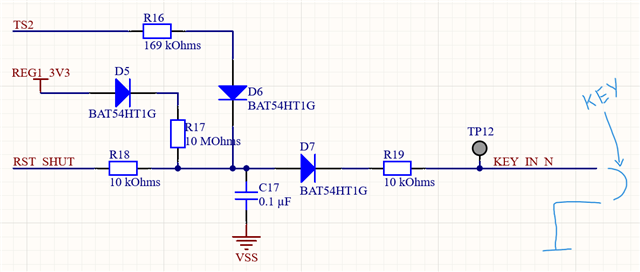Hello,
We would like to implement a system present function with bq76942. A kind of system present function with a key. The battery pack is not removable but a key is supposed to activate the battery (FETs) and if the key is not inserted the battery should be in shutdown state. The required registers are permanently programmed via OTP.
The following link suggests a solution which I have tested and find very good. But the tests revealed certain behavior that gave rise to some questions:
Here is a short schematic that shows the same case that i tested:

Let's assume the following case:
The key is inserted all the time. (System present signal or Key in signal pulled to GND). Therefore battery is connected until an undervoltage event occurs which triggers a shutdown and deactivates the FETs. But because of the circuit, TS2 is pulled low and therefore the device will only go into soft-shutdown mode until someone removes the key and thus TS2 can pull the enable signal to 3-5v and the device will transition into shutdown mode.
Question 1:
Is soft shutdown generally an unwanted situation or is it acceptable for the device to be in soft shutdown for a certain period of time? How big is the power consumption in the soft shutdown state in the case that the key is not removed (the same would apply if the pack is not removed as in the example with the attached link)?
Question 2:
In order to get around the problem, in my opinion there would have to be an analog circuit which does a short pull down when inserting the key on TS2, but the TS2 can otherwise float freely. Unfortunately, I couldn't find such a reference design with pack present/key anywhere. Is there a solution you recommend? For my understanding, that would also mean that in a certain way you have to get a pull-up voltage from the battery, which you would like to avoid because of the current draw...
Thank you for your help in advance



